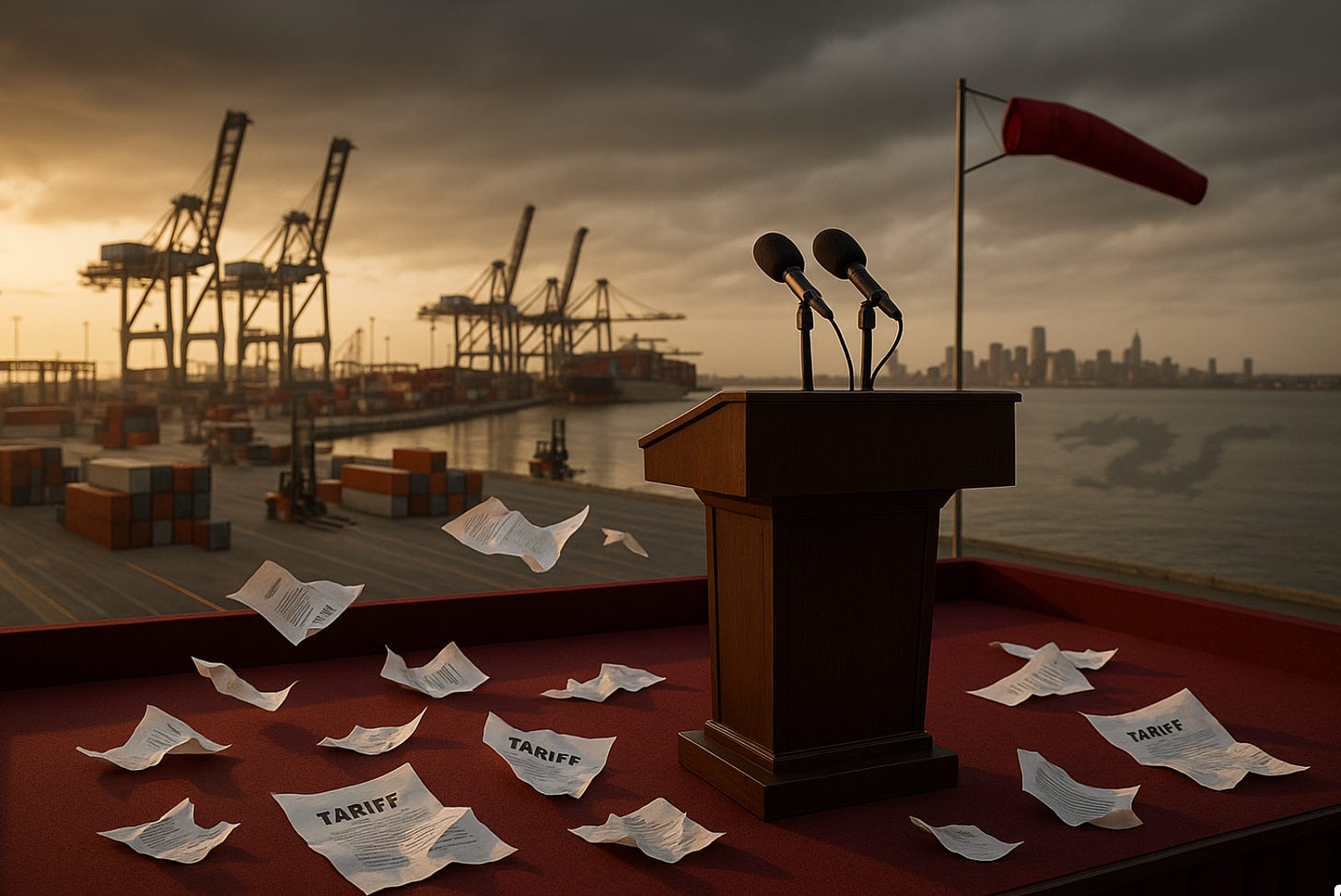The State of Trump's Trade War: Short- & Long-Run Consequences of Optics vs. Economics
Symbolism wins, technocracy bends: the public sees “tough,” firms get exemptions, and growth pays the tab. And then cycle repeats: unilateral tools plus attention incentives make escalation cheap and endless. And so in the long run China writes the rules of world trade and hogs the surplus from the globalized value-chain economy, while the U.S. suffers under the harrow of a BREXIT-like headwind to productivity growth…
Trump’s trade war runs on optics alone, not economics. Loud tariffs with quiet unwinding. That mix stabilizes the short run. But it likely seeds a decade of productivity drag. Foreign leaders have learned the script: flatter publicly, accommodate privately, and move on, while derisking from the United States. The result is political theater. But the real supply‑side costs to U.S. growth are likely to be substantial. And the real wealth and power benefits to China as the global-trade hegemon orchestrator and defender of multilateralism on its terms are likely to be substantial as well.
To start with, recognize that Richard Baldwin is right here:
Richard Baldwin: How Does the Trade War End? <https://rbaldwin.substack.com/p/how-does-the-trade-war-end> <https://www.linkedin.com/pulse/how-does-trade-war-end-richard-baldwin-mifye/>: ‘Trump’s approach to trade war is not economic; it is emotional…. To restore a sense of national strength, to assuage deep-rooted grievances and to end the sense of victimhood held by the President and America’s middle class…. But is that it? Are there no traditional goals?The President’s trade agenda also mentions more traditional goals like boosting manufacturing and raising middle class real incomes. But the actual conduct of trade policy suggests these are not driving the show. They are decorative, not directive…. Reindustrialisation is not a priority…. Boosting real wages is ornamental…. The true objective… [is not… economic transformation, but emotional restoration. A muscular performance of American dominance, of the humiliation of foreign leaders by getting them to kowtow to the President and accept his capriciousness, of retribution for perceived slights, and of the projection of unchallenged American power…. Trump’s trade war isn’t about fixing the economy. It’s about making MAGA America feel like it’s winning again.Importantly, the oddity of this goal is precisely what makes US trade policy so resilient politically. Almost any event can be spun as a win. A viral clip of the British PM picking up papers that President Trump dropped is an American triumph in this trade war…
And this means that there is a path toward, not sanity, but rather much less damage to the productivity of the globalized value-chain economy in the short run than we all thought back last spring:
Richard Baldwin: How Does the Trade War End? <https://rbaldwin.substack.com/p/how-does-the-trade-war-end> <https://www.linkedin.com/pulse/how-does-trade-war-end-richard-baldwin-mifye/>: ‘The US will likely continue bullying smaller trade partners because it can, and because its President loves that sort of thing. But… Trump is likely to keep most US tariffs at 10%… because, rhetorically, America has already won…. A climbdown spun into a chest-thump. And foreign governments, for their part, will have no interest in bursting this magical thinking bubble….
Foreign leaders have, by now, taken Trump’s measure. They understand that beneath the chaos lies a predictable logic…. Flattery and performative adulation is what works…. As Financial Times journalist Ben Hall put it: “optics are everything…. Trump can be persuaded to retreat or cooperate as long as the retreat looks like conquest… [with] quiet accommodations beneath a façade of mutual respect…. [All] can walk away declaring success according to their own playbooks…
But for foreign countries to do this their leaders need to be willing to (a) offer the public kowtow to the dominance of Trump, (b) be able to actually make credible threats of imposing real pain in some dimension that Trump or the Trumpists care about—for example, turning off the power in Ohio—and © not having too many vulnerabilities themselves that Trump, lashing out because he is angry or just because he wants a headline, can push on some 4 AM on Truth Social.
As Richard says, the political-economy dynamic is fascinating. It generates a large degree of short-run stability. The parties most visible to the public and the ones most embedded in the policy apparatus pursue different, complementary goals. On the one hand, a president can claim a symbolic win—announcing “tough” measures and declaring victory—at relatively modest tariff levels that are high enough to satisfy performative politics but low enough to avoid major macroeconomic disruption. On the other hand, the Commerce and Treasury technocracy—nudged by exporters needing foreign market access and importers dependent on global supply chains—quietly works to reopen channels, craft exemptions, and recalibrate enforcement so that, in substance, trade flows revert toward the status quo ante. This asymmetry matters a lot: large rhetorical moves are cheap to manufacture, while large substantive reversals are costly; so the system equilibrates with loud symbolism paired to incremental, bureaucratic unwinding. In effect, the public hears about toughness; the firms get continuity; and nearly the “pre‑April” regime’s practical essence returns under a new banner.
This is why, in the near term, such conflicts don’t escalate: optics do the heavy lifting while policy plumbing cushions the economy.
I wish I could say that that is the end of the story, and that Trump’s Trade Tariffs are:
but a walking shadow, a poor player
That struts and frets his hour upon the stage
And then is heard no more. It is a tale
Told by an idiot, full of sound and fury,
Signifying nothing…
But there is a medium run, and a long run.

